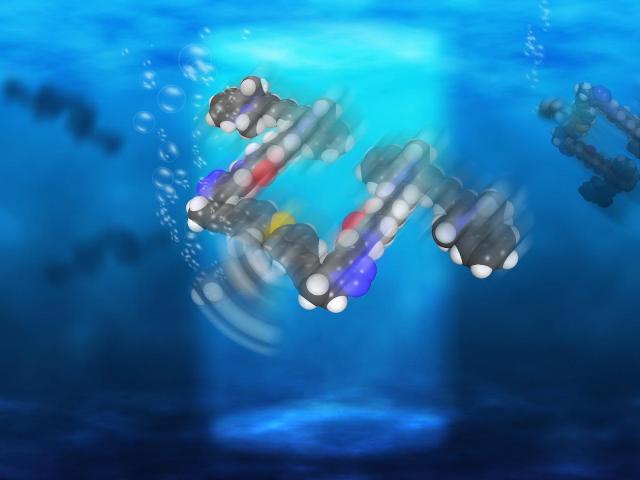Nanoscale submarines, made of only 224 atoms and driven by ultraviolet light, have been produced. It is hoped that this technology can be further developed to allow the transport of molecular cargoes or the delivery of drugs to diseased organs.
 Rice University scientists have created light-driven, single-molecule submersibles that contain just 244 atoms (credit: Loïc Samuel/Rice University)
Rice University scientists have created light-driven, single-molecule submersibles that contain just 244 atoms (credit: Loïc Samuel/Rice University)
The tail-like propeller of the motor thrusts the submarine in the forward direction by a distance of 18 nm with each full revolution. As the motors rotate at a rate of more than one million RPM this amounts to a considerable speed.
Even though this motion may appear slow (the submarine moves at less than 1 inch per second at the motors top speed) at the molecular level this is breakneck speed.
These are the fastest-moving molecules ever seen in solution.
James Tour - Rice University
The motion of the light-powered molecule shows an 'enhancement from diffusion' of 26%. Meaning that the submerisble's motion occurs at a much faster rate than the 'normal' rate of diffusion, which occurs due to the random Brownian motion of molecules.
Although at the moment the researchers, who are based at Rice University, have not developed a method of steering the particles they have shown that the molecular motors can drive the motion of molecules through crowds of molecules of a similar size.
This is akin to a person walking across a basketball court with 1,000 people throwing basketballs at him.
James Tour - Rice University
Tour and his team are highly experienced in the field of molecular machines, it was his laboratory that first introduced nanocars to the world. Nanocars are single-molecule cars fitted with four wheels, axles and independent suspension which can be driven across a surface.
He claimed that though a number of microscopic machines powered by motors have already been created all of these inventions either generated or consumed toxic chemicals. He added that the motor used for powering the Rice subs was created by a Netherland group in the last decade. These motors were created with a 20-step chemical synthesis.
These motors are well-known and used for different things. But we were the first ones to propose they can be used to propel nanocars and now submersibles.
Victor García-López - Rice University
Rather than by a propellor mechanism the novel motor operates more like the flagellum (tails) that bacteria use to swim. Each revolution is completed in four steps. The double bond that links the rotor and the body gets converted to a single bond when excited by light which facilitates the quarter step rotations. Until the time the light is flashed again, the motor jumps adjacent atoms for another quarter rotation in an effort to return to lower energy states.
The team has made different types of subs for comparison tests, one without a motor, one with a slow motor and one with motors that paddle forwards and backward. For each version a pontoon was fitted in the subs, which would fluoresce red light under laser excitation.
One of the challenges was arming the motors with the appropriate fluorophores for tracking without altering the fast rotation.
Victor García-López - Rice University
We had used scanning tunneling microscopy and fluorescence microscopy to watch our cars drive, but that wouldn't work for the submersibles. They would drift out of focus pretty quickly.
James Tour - Rice University
For taking measurements, a drop of diluted acetonitrile which contained a small number of nanosubs was placed between two slides. Using a custom confocal fluorescence microscope the slides were then exposed to UV light from one side and a red laser from the other side.
The tracking of movement was done within a column of light in the solution that was defined by the laser which ensured only one molecule at a time was being measured.
The research team are looking at using the nanosubs to transport cargoes for medical and other applications in the future.
There's a path forward. This is the first step, and we've proven the concept. Now we need to explore opportunities and potential applications.
James Tour - Rice University
The research work was financially supported by North Carolina State, the Welch Foundation and National Science Foundation. The research has been published in the American Chemical Society's Nano Letters.